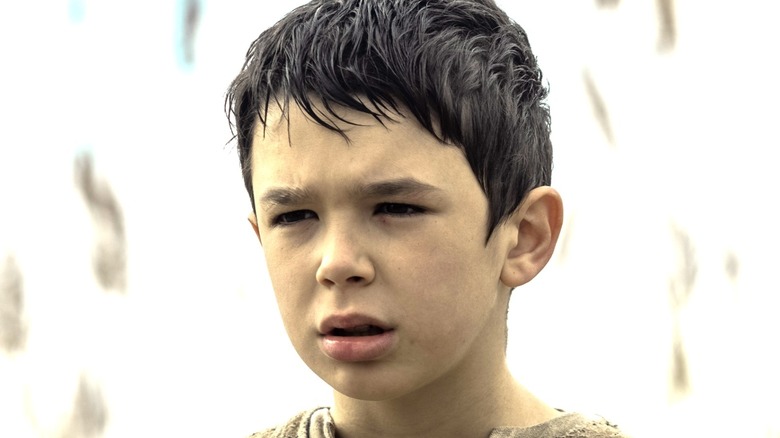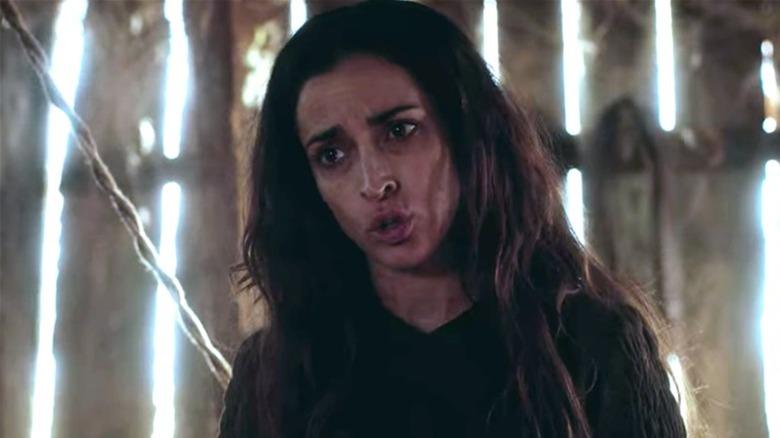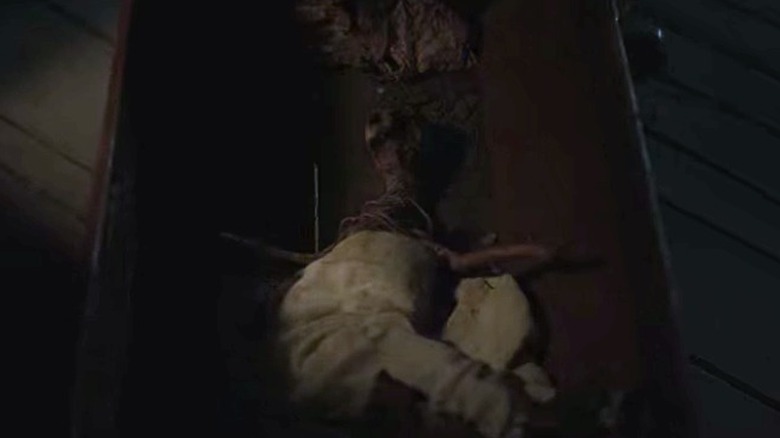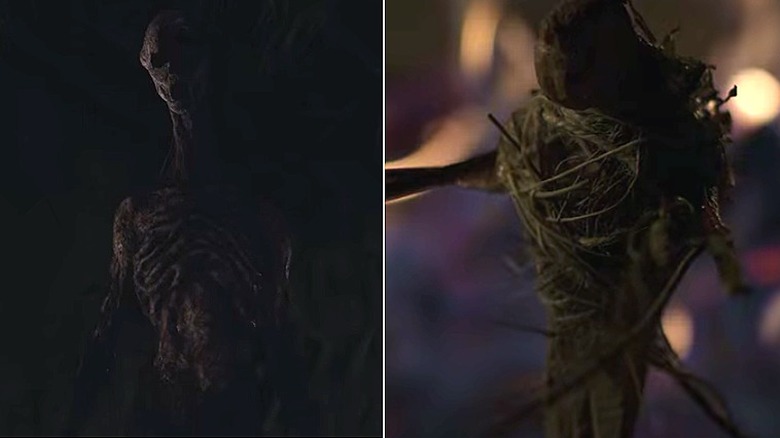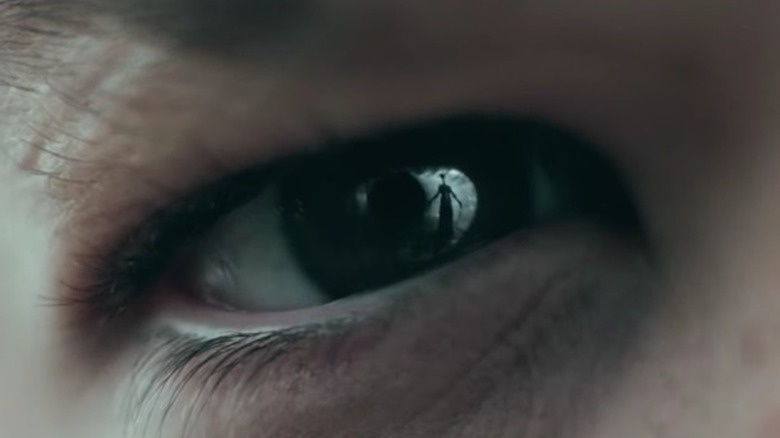The Ending Of Netflix's The Wasteland Explained
Director David Casademunt's psychological thriller, "The Wasteland" (titled "El páramo" in Spanish), debuted on Netflix this past week. Set in 19th-century Spain in the wake of The Peninsula War and the various internal conflicts that followed, the film follows a family of three who've gone into isolation as a means of protecting themselves from the war and destruction that surrounds them. Starring Inma Cuesta as Lucía, a wife and mother whose idyllic pastoral life is about to be upended, Roberto Álamo as her stern and sorrowful husband Salvador, and Asier Flores as the couple's young son Diego, "The Wasteland" is an atmospheric exercise in the psychology of fear, and the desperation to which giving in to its demands ultimately leads.
At the start of the film, the family is living a quiet farming life in a small shack surrounded by an ominous boundary. A series of crucifix-mimicking scarecrows line the outer edge of the property, because, as Lucía explains to Diego, "there are only bad people out there who hurt others." The family's life is upturned when a soldier floats upstream onto their property, clinging to life. Salvador attempts to save him, but the man dies by suicide, and the protective patriarch leaves in order to find the man's family. Amidst all this, we learn of a monster ("The Beast") whom Salvador says feeds on the fear of the weak, coming closer and closer each time they see it. He insists The Beast is responsible for his sister's suicide during his childhood, and that once a person sees it, they're doomed for life.
The Wasteland reinvigorates a timeless story
With Salvador gone, Lucía — who initially doesn't believe in The Beast, and says Salvador's sister was merely "sick in the head" — grows ever more convinced that the Slender Man-reminiscent monster has come for her and Diego. As she makes the slow and painful descent into paranoia and madness, Diego must make the transition from sheltered innocent to determined hero.
"The Wasteland" isn't the first horror thriller to pluck at the pathos that compels us to tell (and retell) stories about ever-encroaching boogeymen and "harbingers of doom." Robert Eggers' "The Witch," Scott Derrickson's "Sinister," David Robert Mitchell's "It Follows," Jennifer Kent's "The Babadook," and — perhaps most obviously — M. Night Shyamalan's "The Village," all touch on the psychology of fear itself. Ultimately, when one strips away all the specific trappings of any given monster narrative, what's left is a simple investigation of the mind's involuntarily compulsion to give fear a tangible structure and form.
In Casademunt's film, however, the addition of self-induced, post-war isolation — and the movie's refusal to confirm or deny the existence of The Beast — brings our obsession with this ambiguous and ominous creature into a stunning relief that hits on something even more unavoidably tragic. Unlike many of its cinematic and mythologic predecessors, "The Wasteland" doesn't shy away from exposing the universal root of this shape-shifting fear for exactly what it is: the unshakeable knowledge of our own mortality.
In The Wasteland, fear itself is more terrifying than any beast
Throughout the majority of the film, Diego catches only blink-and-you'll-miss-it glimpses of the figure his mother insists is terrorizing their home. These sightings appear not when his mother is interacting with or shooting at a creature he's unable to see, but when his own fear reaches a fever pitch in response to her behavior. Unsure if these flashes of the monster are tricks of the mind or an actual creature, Diego realizes his main goal is not to kill The Beast, but to protect his mother from herself as she grows increasingly violent and abusive.
Rather than the pair slipping into a folie à deux, Diego's monster conflicts with his mother's. For instance, he sees it — or thinks he sees it — while attempting to sneak the last bullet out of the shotgun without his mother noticing. In that moment, his fear is not of The Beast, but of what will happen when his mother realizes he's taken her weapon away. Lucía, in contrast, begins seeing The Beast when she accepts that Salvador is dead. Isolated and vulnerable, her fear of being unable to protect her son — despite all she's done to insulate him — turns what she once viewed as folklore into a tangible threat. In one scene, Lucía is "caring for" a poppet that resembles The Beast, rocking it in a cradle while she converses with an invisible monster in place of her husband. Here, Lucía has literally given birth to her own demon. Her biggest fears have come to fruition, and what's worse, she's responsible.
The Wasteland's monster reveal is more than it appears
Diego's confrontation with The Beast is of a different nature entirely. When he finally sees — in his mind's eye, at least — The Beast in all its fully-formed, tangible and horrifying glory, it's because he sees his mother dying. Just as the idea of killing one of his beloved rabbits upset him at the film's start, Diego is most terrified when confronted with the physical death of something he loves. Rather than flee from The Beast, Diego begins screaming at and moving toward it, yelling "get away from her!" In response, the creature begins shrinking, though it doesn't disappear entirely — not even when Diego shoots it at point-blank range. Suddenly, the innocent child whose father thought him weak for being unable to kill his pet demonstrates that the only way to conquer one's fear is to face it head-on. Diego then sets his home ablaze and escapes, a nod to the difference between consumption that corrupts (like fear) and consumption that purifies (like fire).
Importantly, when Diego sees The Beast at the film's climax, the camera cuts to another of Lucía's poppets — one that looks exactly like a straw version of the monster. When the house goes up in flames, it's the poppet, not The Beast, that the viewer watches burn. The scene suggests (though doesn't explicitly confirm) that the monster Diego sees is actually a manifestation of his own fears, and one that exists in physical form only in the child's mind, and in the form of a bundle of sticks and string.
The ending of The Wasteland reveals the film's true monster
Like the boogeymen, banshees, reapers, and shadowy demons of centuries-old mythologies and folklore, The Beast is the embodiment of death itself — an ever-present, ever-looming threat that (quite literally) comes closer and closer with each passing day. Whether real or imagined, the monster is the means by which we give structure to the "unknown" we fear most: that is, what waits for us on the "other side" of death. Subsequently, when Diego musters the courage to finally cross the border around his home for the first time in his whole life, the fear he's actually facing is of that same, unanswerable unknown.
By the end of the film, the previously sheltered Diego is faced with the reality of death, and by extension, of his own mortality. The final scene of "The Wasteland" reveals that it's this knowledge — that such things are inescapable, and continually moving in on us — that The Beast truly represents. The scars on Diego's hands at the film's conclusion reiterate this theme and mirror the similarly-earned scars he saw on his father's hands. In a literal way, these scars represent the psychological wound created by a knowledge of (and exposure to) death and finality. In a less literal but equally tangibly way, the glimpse of The Beast we see in Diego's eye at the film's conclusion suggests that while we may be able to face, accept, or (as Diego's mother says) "carry on" with this knowledge, our fear of what it means never truly goes away.
